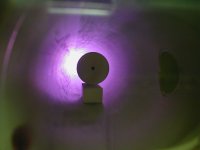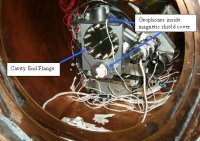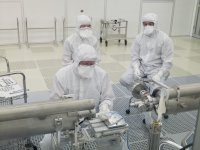From SLAC Today: Clearing Clouds

The circular device inside this accelerator structure coats the structure with titanium nitride to keep electron clouds in check. |
Clouds might be welcome during a drought, but you definitely don't want them in your beam pipes. Researchers around the world are working out how to keep a section of the proposed International Linear Collider—the positron damping ring—clear of electron clouds.
In curved sections of accelerators, such as a damping ring, the beam throws off synchrotron radiation that plows into the beam pipe walls, kicking up electrons embedded in the wall. The newly freed electrons get pulled along with the next bunch of positrons in the beam, but then some hit the wall, freeing so-called secondary electrons. Soon a cloud of electrons clogs up the beam pipe.
Read more...
-- Heather Rock Woods, SLAC Today |
 |
|
|
 |
Upcoming meetings, conferences, workshops
Lepton-Photon 2007
Daegu, Korea
13-18 August 2007
CHEP 07 - International Conference on Computing in High Energy and Nuclear Physics
Victoria, Canada
2-7 September 2007
VII International workshop on Problems of Charged Particle Accelerators: Electron-positron Colliders
JINR-BINP, Alushta (Crimea, Ukraine)
2-8 September 2007
TWEPP 2007
Prague, Czech Republic
3-7 Sept 2007
IEEE EUROCON 2007
Warsaw, Poland
9-12 Sept 2007
12th International Workshop on Polarized Sources and Targets (PST 2007)
Brookhaven National Laboratory
10-14 September 2007
ILC Positron Source Collaboration Meeting
Argonne National Laboratory
17-19 September 2007
Workshop on ILC Interaction Region Engineering Design
SLAC
17-21 September 2007
Upcoming schools
2007 SLAC Summer Institute
Stanford Linear Accelerator Center
30 July - 10 August 2007
Second International Accelerator School for Linear Colliders
Ettore Majorana Center, Erice (Sicily), Italy
1-10 October 2007
|
|
 = Collaboration-wide Meetings = Collaboration-wide Meetings
GDE Meetings calendar
View complete ILC calendar
|
|
|
 |
Good vibrations at Fermilab

Two of the geophones installed in Fermilab's Horizontal Test Stand. |
Vibrations in the cryomodules in the International Linear Collider are actually not a good thing. The slightest disruption can throw off the alignment of the super sensitive beams and prevent them from colliding. The stringent beam dynamic requirements in the ILC therefore make vibration studies important, which is why Fermilab recently installed measuring devices called geophones in their Horizontal Test Stand. So for the team at Fermilab, detecting vibrations now, during an R&D phase, is actually a good thing because it means that they can learn how to minimise them in the actual machine when every collision counts.
Read more...
-- Elizabeth Clements |
 |
|
|
 |
From Berliner Zeitung
9 August 2007
Weltbewegendes aus der Hamburger Unterwelt
...Der eigentliche Beschleuniger im Tunnel bleibt erhalten und wird gegen Korrosion geschützt. Er könnte beispielsweise als Testgelände für andere Teilchenbeschleuniger, wie den geplanten International Linear Collider (ILC), verwendet werden.
Read more... |
|
From Fermilab Today
8 August 2007
Congressional visit to Fermilab focuses on the future
...“I am interested in funding for Fermilab and basic and applied science research,” Lipinski said. “My visit helps me to get a better idea of Fermilab's future, including plans for the ILC, which is critical for the future of particle physics at Fermilab and in the U.S.”
Read more... |
|
From SLAC Today
7 August 2007
Dark Matter - What's out there?
For thousands of years, people have gazed at the stars and wondered, “What's out there?”
Read more... |
|
From Physorg.com
6 August 2007
LCLS Beam Already in Action
...In early July, the beam was first pressed into service to help set up a suite of International Linear Collider (ILC) experiments coordinated by Mike Woods.
Read more... |
|
From the Chicago Tribune
5 August 2007
Supercollisions on the horizon?
The project staggers the imagination: a machine that would stretch 20 miles through the bedrock 400 feet beneath Kane, DuPage and perhaps Will Counties.
Read more... |
|
From SLAC Today
3 August 2007
Practical Sabbatical
Tom Himel doesn't know German, but he expects to have much to share and much to learn when he spends a year in the northern German city of Hamburg starting on Tuesday, August 7.
Read more... |
|
From Interactions.org
3 August 2007
Brookhaven Physics Leaders Satoshi Ozaki and Michael Harrison Receive IEEE's Particle Accelerator Science & Technology Award
Satoshi Ozaki and Michael Harrison, physicist-administrators at the U.S. Department of Energy's (DOE) Brookhaven National Laboratory who led the decade-long development and construction of the Laboratory's world-class particle accelerator, the Relativistic Heavy Ion Collider (RHIC), were awarded the 2007 Particle Accelerator Science & Technology Award.
Read more... |
|
|
 |
Siting the ILC: Reference design for the conventional facilities

The ILC reference design features a double tunnel configuration deep underground. |
Where will the ILC be built? This is one of the first questions people ask me whenever I give a presentation on our ambitions to build a new accelerator for particle physics. The answer, of course, is that we just don’t know! Although we are working towards a siting plan, the uncertainty where the ILC will be built is likely to continue through the engineering design phase. Nevertheless, by working on designs for a set of “sample sites,” we have made a lot of progress in understanding key issues involved in siting. This is especially true for the scope of the conventional facilities and the estimated costs.
Read more...
-- Barry Barish
Director's Corner Archive |
 |
|
|
 |
|
Putting the pieces together

DESY technicians recently spent some time at Fermilab to assist in putting together the first “cryomodule kit” shipped from Germany to Chicago, Illinois. Stay tuned to ILC NewsLine for a full report on their visit.
|
|
arXiv preprints
708.0142
1 Aug 2007
The 4th Concept Detector for the International Linear Collider
708.0134
1 Aug 2007
LHC Physics and Cosmology
EUROTeV Reports
2007-043
Technical Challenges for Head-on Collisions and Extraction at the ILC
2007-044
Measurements of the Transverse Wakefields Due to Varying Collimator Characteristics
|
|

